There are about 42 species of Snakes in Kansas, only 4 of which are considered venomous.
Whether you are from Kansas or are just curious as to what species you might encounter in the state, this list will give you the basic details about each species.
While it is legal to kill snakes in Kansas, you may only do so once you have obtained a license, which will cost around $22 to get.
Non-native venomous snakes are considered illegal to keep as a pet in the state as well.
Now that you know a bit more about the legal side of owning and hunting snakes in Kansas, here is a list of the snake species that roam Kansas:
Here are some common snakes that roam the state:
Table of Contents
Snakes in Kansas
1. New Mexico Threadsnake

- Experience Level: Intermediate
- Family: Leptotyphlopidae
- Scientific Name: Rena dissecta
- Other Names: New Mexico Blind Snake
- Adult Size: 5 to 8 inches
- Lifespan: Unknown
These thread snakes are currently in threatened extinction, but they are still currently in existence, thankfully. They are a harmless species of blind snakes.
They are a uniform tan or pinkish coloration with small, black, beady eyes, and scaley undersides.
They can be found in southern counties along the border of Kansas and Oklahoma.
They make burrows in moist, loose soil with rocky sandy cover.
They feed on termites and ants, but mainly their eggs, larvae, and pupae.
2. Glossy Snake
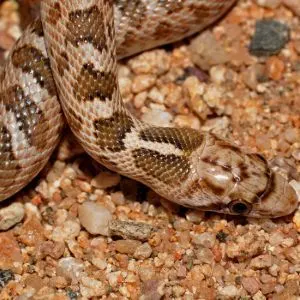
- Experience Level: Beginner
- Family: Colubridae
- Scientific Name: Arizona elegans
- Other Names: Faded Snake
- Adult Size: 30 to 50 inches
- Lifespan: 10 to 18 years
These slow-slithering, nocturnal beings look very similar to gopher snakes with pointed, narrow heads and similar coloration.
They have tan to light brown bodies with a faded look, hence their names, and brown blotches all throughout their length. Their undersides are typically cream or pale yellow in color and they have shiny-looking scales, giving them an almost glossy finish.
They are fairly large in size and are pretty easy-going, making them good pets as well.
They like to inhabit dry areas such as grasslands, deserts, sagebrush, chaparral, and pine-juniper.
They mainly feed on vertebrates such as lizards, rodents, smaller snakes, smaller birds, and sometimes insects. They consume their prey by constricting them with their tight grip, suffocating them, then eating them whole.
3. North American Racer

- Experience Level: Intermediate
- Family: Colubridae
- Scientific Name: Coluber constrictor
- Other Names: Black Racer, Racer, North American Blue Racer
- Adult Size: Anywhere from 20 to 65 inches
- Lifespan: 10 years
These slender snakes are versatile and are not dangerous or venomous. They are called racers because they are very fast-moving.
They are mostly docile creatures. However, if they feel threatened, they are ready to defend themselves. In most cases, it can be quite hard for these snakes to become accustomed to handling.
These snakes are silvery-grey and can sometimes be an almost metallic-looking electric blue. North American Racers will have a pale yellow or white underside and a black tongue.
A bite from them is shocking but harmless to humans or larger pets like dogs or cats.
They inhabit young or regrowing forest edges and shrubland. These Racers feed on small mammals, insects, smaller snakes, and lizards by swallowing them alive.
4. Prairie Kingsnake

- Experience Level: Beginner
- Family: Colubridae
- Scientific Name: Lampropeltis calligaster
- Other Names: Yellow-bellied Kingsnake
- Adult Size: 30 to 40 inches
- Lifespan: 23 years
This species is typically tan or brownish grey, sometimes with a tint of green-grey and numerous dark brown, copper-colored, or green-brown blotches down their back.
They also have a tan or pale yellow underside and a V- or U-shaped marking on their head.
They can be found in the Southeastern United States, ranging from Maryland to Florida and Nebraska to Texas.
They enjoy habitats with open grasslands that have dry, loose soil near permanent water sources. An example of this type of habitat can include forest edges.
Prairie Kingsnakes typically feed on rodents, but will also consume amphibians, lizards, birds, their eggs, and even other snakes.
When they are feeling defensive, they will shake their tails in a similar manner to a rattlesnake. They may also release musk and flatten their heads in a defensive stance, but don’t be fooled because they will typically not try to bite anyways.
5. Speckled Kingsnake

- Experience Level: Beginner
- Family: Colubridae
- Scientific Name: Lampropeltis holbrooki
- Other Names: Speckled King Snake
- Adult Size: up to 48 inches
- Lifespan: around 15+ years
As their name suggests, these snakes are typically yellow or lime green with a black layer then their original yellow or lime coloration speckled on top of that dark, contrasting black. This speckled look is what gives them their name.
Speckled Kingsnakes can be found in the central and southern states from Iowa all the way to the Gulf of Mexico. They make homes out of moist habitats like rivers and swamps but can also be found roaming dry woodlands or grass fields sometimes.
They feed on other snakes and rodents primarily, but will also consume the occasional fish. They will even eat a Cottonmouth if given the chance!
6. Eastern Milksnake

- Experience Level: Beginner
- Family: Colubridae
- Scientific Name: Lampropeltis triangulum
- Other Names: Milk Snake
- Adult Size: About 4 feet
- Lifespan: 22 years
Milk Snakes are a species of Kingsnake that are non-venomous, friendly, docile, and beautiful to look at.
Milksnakes are tan or brown with black-brown bands and blotches that loop around the length of their body. Their skin can sometimes be a pale yellow with almost a red striped pattern, similar to the Western Milk Snake and the venomous Coral snake or a Rattlesnake, depending on the Milk Snake.
They have cat-like pupils that can look intimidating but lack the rattle at the end of their tails.
They can be found in meadows, pastures, under any artificial cover, by the edges of watercourses, by mountain cliffs, and woodlands. These carnivorous snakes feed on lizards, reptile eggs, birds and their eggs, mice, and sometimes insects.
7. Coachwhip

- Experience Level: Expert
- Family: Colubridae
- Scientific Name: Masticophis flagellum
- Other Names: Whipsnake
- Adult Size: 5 to 8 feet
- Lifespan: 16 to 20 years in captivity; Wild lifespan: 13 years
Coachwhips are thought to be some of the quickest snakes in America.
Coachwhips are fairly slender with distinctive black or dark brown head and ombre colorations with lighter browns and tans down their backs toward their tail.
They have large eyes, which give them great vision as they swiftly sweep the terrain for prey.
You can find them in any dry terrain such as prairies, farmlands, deserts, shrublands, juniper grasslands, creek valleys, and chaparral. You might also find them roaming around agricultural areas with vegetation.
They eat a diet of mainly rodents, frogs, lizards, birds, and their eggs, spiders, and even small venomous snakes. They are also known to eat rattlesnakes if they happen to cross paths with one.
8. Rough Greensnake

- Experience Level: Beginner
- Family: Colubridae
- Scientific Name: Opheodrys aestivus
- Other Names: Green Snake, Grass Snake, Rough Green Snake
- Adult Size: 2 to 3 feet
- Lifespan: 8 years in captivity; wild lifespan unknown
Rough Green Snakes remain healthy in population and can make great diurnal pets for someone who is more of an observer. They don’t really like being handled and prefer sitting in their enclosure.
They are docile beings and will rarely ever try to bite, if at all.
These green snakes look very similar to their cousins, the Smooth Green Snake, with totally lime green bodies and cream-colored undersides. However, if you want to know the differences between these two, it lies in their scales.
Smooth Green Snakes do, indeed, look smoother due to their flat, shiny scales whereas Rough Green Snakes have more raised scales with keels on the scales covering their dorsal and sides. They will also have larger eyes than their “smooth” counterparts.
These green snakes love to live among the vines, shrubbery, and leaves of trees. They like thick vegetation, lush streamside forests, moist woods, and the gardens in our very backyards.
They usually live off insects like crickets and grasshoppers, but will also consume spiders, small frogs, and snails. They hunt using their large eyes and excellent vision.
9. Smooth Greensnake
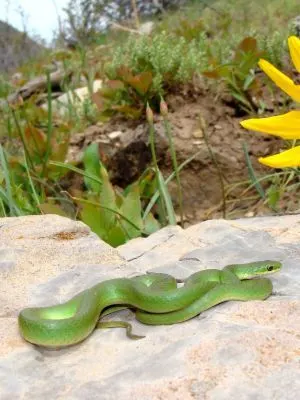
- Experience Level: Intermediate
- Family: Colubridae
- Scientific Name: Opheodrys vernalis
- Other Names: Green Snake, Smooth Green Snake
- Adult Size: 14 to 20 inches
- Lifespan: 6 years
While you can find these snakes out in the wilderness, they are rarely encountered due to their timid nature.
Smooth Green snakes can make great pets for any owner that is a little squeamish about feeding them dead rodents. These guys will mostly eat insects like spiders, moths, ants, snails, slugs, worms, and spineless caterpillars.
However, it is said that they do not make great pets since they are way too timid for human interaction. However, they are harmless and some enjoy being handled.
They can be found in open woods, stream edges, marshes, and meadows. They thrive in moist, grassy areas.
As you can already tell by their name, these snakes will be a bright green, which can range in shade. They stay relatively small and may have a pale yellow underside with beady eyes.
These are not the easiest snakes to keep captive since they are very anxious and easily stressed out.
10. Great Plains Rat Snake

- Experience Level: Beginner
- Family: Colubridae
- Scientific Name: Pantherophis emoryi
- Other Names: Great Plains Ratsnake
- Adult Size: 3 to 5 feet
- Lifespan: 15 to 20 years
The Great Plains Ratsnake is typically a tan or lighter gray in color with brown, dark gray, or greenish-gray blotches down its back and a light tan stripe on each side of its head that meet between its eyes.
They don’t have very large teeth and are non-venomous, but do tend to be bitey. Most of the time they are not aggressive, though.
They live in a wide variety of areas such as brushes, hill prairies, fields, canyons, barnyards, woodlands, riparian areas, and will even make homes out of abandoned houses. They like any place that they can hide under logs, rocks, boards, and even existing abandoned animal burrows.
As their name suggests, rodents will be a huge part of their diet but they also eat lizards, frogs, and birds. They will sit and wait until they see prey before they strike, constrict, and swallow their prey.
They are called Rat Snakes, meaning they can be useful in helping you get rid of the overpopulation of rodents in your home, if needed.
This is why they are beneficial and sometimes kept by farmers.
11. Western Rat Snake
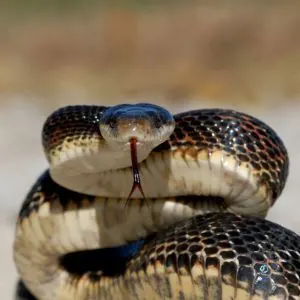
- Experience Level: Intermediate
- Family: Colubridae
- Scientific Name: Pantherophis obsoletus
- Other Names: Black Rat Snake, Pilot Black Snake, Black Snake
- Adult Size: 3 to 6 feet
- Lifespan: 6 to 8 years
Black Rat Snakes are large snakes, growing up to 6 feet long. They are also the most popular type of Rat Snake to keep in America due to their docile nature, hefty size, and ability to help with rodent control.
As their name suggests, they are primarily black in color and may have faint white bands in between their scales. They usually have a white underside starting from their chins downward.
Hobbyists love these interesting creatures for their ability to help with pest control. They are called Rat Snakes, meaning they can be useful in helping you get rid of the overpopulation of rodents in your home, if needed.
This is why they are beneficial and sometimes kept by farmers.
They can be found in mountainous regions, rocky hillsides, or flat farmlands. They survive at various elevations and are actually proficient climbers, making homes in tree cavities that used to be the homes of other animals.
They consume rodents, amphibians, lizards, and also bird eggs.
12. Gophersnake

- Experience Level: Intermediate
- Family: Colubridae
- Scientific Name: Pituophis catenifer
- Other Names: Gopher Snake
- Adult Size: 4 to 7 feet; can reach up to 9 feet
- Lifespan: 12 to 15 years; up to 30 years in captivity
The Gopher Snake is very heavy-bodied and is quite long in length. They are pretty docile creatures except when threatened.
These guys will require a very secure enclosure as they are escape artists. They also require a lot of space due to their size and active nature.
Gopher snakes are usually a light tan to brown color with large, dark brown, sometimes reddish-brown spots and lined patterns throughout their length. Sometimes they are mistaken for rattlesnakes, but you would just have to identify them by their lack of a rattler.
They can be found in warm, dry, forested areas.
They really like to eat small rodents, which is actually how they got their name. They help keep the rodent population down in whatever area they roam.
13. Long-nosed Snake

- Experience Level: Expert
- Family: Colubridae
- Scientific Name: Rhinocheilus lecontei
- Other Names: Longnose Snake
- Adult Size: 30 to 40 inches
- Lifespan: less than 20 years
Long-nosed Snakes are not commonly found in the pet trade because they are difficult to keep since they are notorious escape artists.
They get their name from their slightly upturned, long snout somewhat resembling a shark nose.
They look very similar to a Coral Snake or Milk Snakes with their black and red-orange stripe-like pattern except Long-nosed snakes will have somewhat faded-looking sides which are almost a checkered pattern of the same colors as their body. They also have a light yellow or cream-colored body, which looks like a background under other colors.
These nocturnal beings like arid environments such as deserts and dry prairies where they burrow during the day and crawl on cool roads at night.
These snakes feed primarily on amphibians and lizards but will sometimes be caught eating other smaller snakes and the occasional rodent.
14. Western Earth Snake

- Experience Level: Intermediate
- Family: Colubridae
- Scientific Name: Virginia valeriae
- Other Names: Western Smooth Earthsnake, Western Ground Snake
- Adult Size: 7 to 19 inches
- Lifespan: Unknown; Shorter in captivity
Western Ground Snakes are on the smaller side and can range from light browns to greys or even a copper-like color. Their undersides are typically cream or off-white and they do not have any distinctive markings.
They are endemic to North America and have many different subspecies that might variate in coloration or patterns depending on their geographical region.
They like to live in habitats that are warm and humid. They prefer woodlands, moist woods, or woody hillsides where they can be found hiding under rocks and leaf litter.
They are nocturnal and like to hunt at night. These snakes feed on soft-bodied insects such as earthworms and slugs.
15. Flathead Snake

- Experience Level: Intermediate
- Family: Colubridae
- Scientific Name: Tantilla gracilis
- Other Names: Flat-headed Snake
- Adult Size: 7 to 8 inches
- Lifespan: Unknown
This tiny snake is tan or brown sometimes with a lighter underside and, as its name suggests, a flat head.
You can find these little guys in the Lower Rio Grande Valley at the border of Texas and Mexico as well as in Kansas and Missouri. They thrive in moist soil where they can burrow or hide under rocks.
They like rocky wooded hillsides with sandy soils and limestone. They typically burrow underground during the winter or overly hot weather.
Flathead Snakes feed on various insects including scorpions, spiders, centipedes, and more.
16. Plains Black-headed Snake
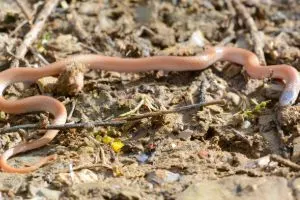
- Experience Level: Intermediate
- Family: Colubridae
- Scientific Name: Tantilla nigriceps
- Other Names: Plains Blackhead Snake
- Adult Size: 7 to 15 inches
- Lifespan: Unknown
Plains Black-headed Snake has a uniform tan to grayish-brown body with a pink-orange underside. Some may have lavender colorations on their neck and chin.
At the top of their head, they have a large black or dark blue that seemingly covers the entirety of their head, which is where they get their name.
You might find them in grassy, rocky prairies, or in hillsides with moist soil. People have even spotted them in their basements.
They mostly eat spiders and beetle larvae, but will also eat centipedes and sometimes scorpions.
17. Western Wormsnake

- Experience Level: Intermediate
- Family: Colubridae
- Scientific Name: Carphophis vermis
- Other Names: Worm Snake
- Adult Size: 7.5 to 11 inches
- Lifespan: 4 years in the wild
Since these tiny worm-like snakes can be found in the wild, they can be tempting to take home and try to keep as a pet. However, most of the time, they will die within a week or two in captivity due to their refusing to eat when they are in a changed habitat.
They will also just be hiding in the substrate the whole time since they do not like to be exposed. This will also make it hard for keepers to monitor their health.
You can find them under rocks or underground in exposed prairies, open woodlands, rocky hillsides, and any wooded areas.
They are two-toned with dark black or purple bodies and pink or red bellies.
18. Ringneck Snake

- Experience Level: Intermediate
- Family: Colubridae
- Scientific Name: Diadophis punctatus
- Other Names: Ring-necked Snake
- Adult Size: 10 to 15 inches
- Lifespan: 20 years in the wild; 6 years in captivity
Ringneck Snakes have slender bodies and smooth scales, ranging from black, bluish-black, greenish-gray, to olive in color. Their undersides will usually be yellow, orange, or red with a ring around their neck of the same color.
You can find these snakes in a wide variety of habitats as long as there is a lot of places for them to hide and take cover. They like making dens under woody debris.
They typically feed on terrestrial worms, mollusks, and amphibians.
19. Plains Hog-nosed Snake
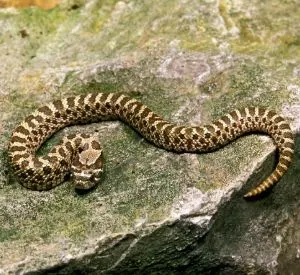
- Experience Level: Beginner
- Family: Colubridae
- Scientific Name: Heterodon nasicus
- Other Names: Plains Hognose Snake, Western Hognose Snake, Hognose snake
- Adult Size: 15 to 25 inches
- Lifespan: about 10 to 15 years
The Hognose snake is known to be one of the best pet snakes for enthusiasts since they are not fussy and are comfortable with human interaction.
They also stay relatively small and have a cute, lovable face with their tiny snout, as their name suggests.
These worm-like snakes have a small snout and a pug-like face. They are usually a light yellow or tan color with a brown spotted pattern throughout their bodies.
They are known to be pretty easy to care for in terrariums and come from dry environments with low vegetation, abundant in rocks or stones. They enjoy digging and prefer sandy areas with space to burrow.
Hog-nosed snakes like to eat frogs and toads, even poisonous ones. However, they will also feed on lizards, small mammals like birds, insects, and salamanders.
20. Eastern Hog-nosed Snake

- Experience Level: Beginner
- Family: Colubridae
- Scientific Name: Heterodon platirhinos
- Other Names: Eastern Hognosed snake, Eastern Hognose
- Adult Size: 20 to 33 inches
- Lifespan: 12 years
The Hognose snake is known to be one of the best pet snakes for enthusiasts since they are not fussy and are comfortable with human interaction. They also stay relatively small.
These worm-like snakes have a large, round head with an upward-facing snout, which is what we all love about them. They are dark gray or olive-green, but some are also yellow, tan, or light brown with dark brown spotted patterns on their head and sometimes their bodies.
They prefer to inhabit sandy woodlands, farmland, coastal areas, and fields where they feed on frogs, salamanders, invertebrates, birds, and small mammals. They can use their hog-like nose to get into their prey’s burrows more easily.
21. Chihuahuan Night Snake
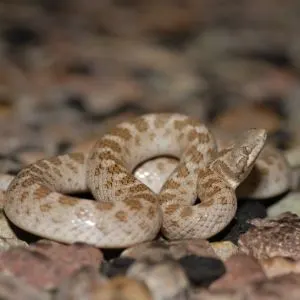
- Experience Level: Intermediate
- Family: Colubridae
- Scientific Name: Hypsiglena jani texana
- Other Names: Texas Night Snake, Texas Nightsnake
- Adult Size: 26 inches
- Lifespan: 12 years in captivity; Wild unknown
You can identify these snakes with their tan or light gray color and dark brown or gray blotches. They have smooth dorsal scales and their undersides are unmarked.
They have copper eyes with a vertically elliptical pupil.
You can find them in semi-arid areas with rocky dirt or soil since that is their preference. In this habitat, they eat mostly smaller snakes and soft insects without an exoskeleton.
22. Plain-bellied Watersnake

- Experience Level: Beginner
- Family: Colubridae
- Scientific Name: Nerodia erythrogaster
- Other Names: Plain-bellied Water Snake, Plainbelly Water Snake, Blotched Snake
- Adult Size: 30 to 48 inches
- Lifespan: Up to 10 years in captivity; wild lifespan unknown
The Plain-Bellied water snake is large, hefty, and solid in color. They will usually be green-gray, solid gray, brown, olive green, or just black in color. They can be distinguished from other water snakes by checking for their unmarked, or plain, underside which might be pale yellow or red.
They like to live in forest edges, ponds, lakes, streams, and bays where they eat fish, crayfish, tadpoles, amphibians, and salamanders.
23. Diamondback Water Snake

- Experience Level: Intermediate
- Family: Colubridae
- Scientific Name: Nerodia rhombifer
- Other Names: Diamondback Watersnake
- Adult Size: 3 to 5 feet
- Lifespan: 9 years
Diamondback Watersnakes are mostly brown or olive green with a black almost net-like, diamond-shaped pattern, which is where they get their names.
You can find them in the central United States or in the northernmost parts of Mexico. They can also range within a lot of southern states such as Oklahoma, Kansas, Arkansas, Missouri, Illinois, Tennessee, Mississippi, Alabama, Georgia, Iowa, Louisiana, Oklahoma, and Texas.
They inhabit aquatic settings such as lakes, marshes, ponds, rivers, streams, canals, creeks, ditches, and swamps.
They frequent shallow waters looking for amphibians, carrion, and slow-moving fish. They are nocturnal hunters and prefer to feed in warmer weather.
24. Common Watersnake

- Experience Level: Beginner
- Family: Colubridae
- Scientific Name: Nerodia sipedon
- Other Names: Watersnake, Northern Watersnake
- Adult Size: 24 to 55 inches
- Lifespan: 9 years
Northern Water Snakes are popular pets since they do not require much effort and are relatively safe, even around children. They can also grow fairly large in size.
They are usually dark in color, ranging from brown, tan, to gray, and have keeled scales. They also have square blotches on their backs and sides that may alternate or become bands throughout their length.
Water Snakes typically live in or near aquatic habitats which is why they are called water snakes. They like to bask on rocks by still or slow-moving water such as seasonal pools, lakes, and ponds.
You might see them swimming and hunting the waters as well.
They like to eat fish and amphibians, swallowing them whole and alive. They eat all kinds of fish species such as smallmouth bass, minnows, bullhead catfish, hogsuckers, sunfish, and brook trout.
25. Graham’s Crayfish Snake

- Experience Level: Intermediate
- Family: Colubridae
- Scientific Name: Regina grahamii
- Adult Size: 14 to 24 inches
- Lifespan: Unknown
Graham’s Crayfish Snakes are a subspecies of Watersnake that shouldn’t be taken out of the wild into captivity.
They are hefty snakes with smooth, dull, brown-olive scales, two light cream or pale yellow stripes down their body, and large eyes with short heads.
They are native to the central United States and are frequently encountered in Iowa.
They like to make homes out of sloughs, floodplains, ditches, marshes, ponds, woodlands, and prairie streams.
They are burrowing snakes that like to make homes near the water’s edge where they feed on amphibians, tadpoles, fish, crayfish, especially newly molted crayfish.
26. Dekay’s Brownsnake

- Experience Level: Beginner
- Family: Colubridae
- Scientific Name: Storeria dekayi
- Other Names: Brown Snake, DeKay’s Brown Snake
- Adult Size: approximately 13 inches
- Lifespan: 7 years in captivity; unknown in the wild
Brownsnakes are not shy and humans commonly encounter them. They can make great pets for beginners due to their size and gentle nature. They are also quite easy to feed.
These non-venomous snakes are usually brown in color, as their name suggests, but can also come in a yellowish, red, or grayish-brown tone.
They will typically have two rows of either darker or lighter spots which might also be linked, making it look like a collar or middorsal streak down the side of their head. Underneath each of their eyes may also be a small, dark spot.
These markings may also not appear on some individuals.
Their undersides will either be white or tan.
They like to reside in various woodlands, more commonly in wet areas like swamp edges or wetland borders. They like to roam the litters of abandoned fields, lowland hardwoods, prairies, and oak savannas.
They are also often spotted in residential areas or urbanized territories.
In their habitats, they will consume small invertebrates like earthworms, slugs, and snails with their specialized jaws and teeth. They may also eat beetles and salamanders if they come across one.
27. Red-bellied Snake
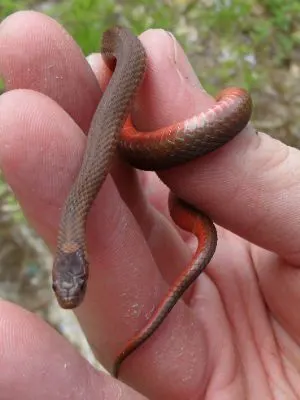
- Experience Level: Intermediate
- Family: Colubridae
- Scientific Name: Storeria occipitomaculata
- Other Names: Redbelly snake, Red-belly Snake, Copperbelly Snake, Northern Red-bellied Snake
- Adult Size: 8 to 16 inches
- Lifespan: 4 years in captivity; Wild lifespan unknown but predicted to be longer than in captivity
While Red-bellied Snakes are rarely encountered in the state, they still exist in the wilderness. They are just very secretive.
These small snakes can be found in swarms basking in the sun on the warm days of September to October. You can also find them in woodlands, fields, under logs, in forests, bike trails, back roads, and sphagnum bogs.
In these areas, they feed on earthworms, beetle larvae, and slugs.
People can sometimes find them out in their pesticide-free garden or just out in the wild and might want to keep them as a pet. However, they really struggle to eat when in captivity and will sometimes just outright refuse when they are removed from the wild.
They do not do well in captivity and prefer to be free to roam the lands as they please. Although they aren’t hard to obtain in the wild, they might not be the best pet to keep if you are planning to have them for long since they do not do well away from their natural habitat.
Due to this, you might not run into them as often in the wild since they like to stick to their spaces. They are not as tolerant of populated areas.
It’s not hard to identify these snakes since they really do live up to their name with their flashy red or orange undersides. Their bodies might be a dark steel grey, black with a blue tint, or copper brown. Some may also have two dark stripes along their sides or a thick, light-colored band down the middle of their backs.
While they will usually first curl their tails or flee in defense before they try to bite, their little nibble probably won’t affect you anyway.
While they are small and beautiful, this does not mean they will make a good pet since they do not usually survive long in captivity.
28. Checkered Gartersnake
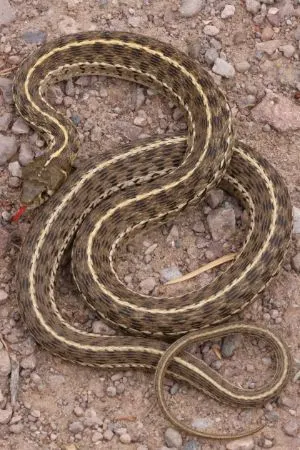
- Experience Level: Beginner
- Family: Colubridae
- Scientific Name: Thamnophis marcianus marcianus
- Adult Size: 2 feet
- Lifespan: 4 to 5 years in the wild; 10 years in captivity
Checkered Gartersnakes are usually olive green or brown-green in color with a distinct checkerboard pattern on their sides as well as a pale yellow or tan stripe down the middle of the length of its back.
They can be found in arid and semi-arid habitats such as savannas, thornbush savannas, deserts, grasslands, forests, and tropical forests.
They will consume anything they are capable of overpowering such as earthworms, slugs, leeches, amphibians, frog eggs, and rodents.
29. Western Ribbonsnake
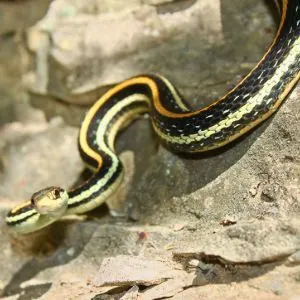
- Experience Level: Beginner
- Family: Colubridae
- Scientific Name: Thamnophis proximus
- Other Names: Ribbon Snake
- Adult Size: around 3 feet
- Lifespan: 10+ years in captivity; wild lifespan unknown
Another Ribbonsnake, which is the most common species of Garter Snakes, is the Western Ribbonsnake. As we mentioned with the Eastern, they have various morphs to pick from and are non-poisonous, making them an attractive pet choice.
Similar to the Eastern, Western Ribbonsnakes can be brown, almost black, or olive-colored with their signature pale yellow or light green stripes along their bodies.
Ribbonsnakes are semi-aquatic and can be found near a water source like the shorelines of rivers or lakes. They will sometimes inhabit water edges near forests or wetlands.
They are carnivorous and mainly feed on small fish, insects, and tadpoles.
30. Plains Gartersnake
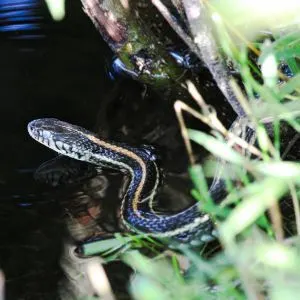
- Experience Level: Beginner
- Family: Colubridae
- Scientific Name: Thamnophis radix
- Adult Size: 16 to 28 inches
- Lifespan: 5 years; sometimes up to 8 years
These non-venomous snakes are friendly by nature, making them a great pet for beginners. They are also relatively small, meaning they aren’t fussy and are easy to care for.
They are black with a distinctive, long yellow or orange stripe running along the whole length of their body. They eat anything they can get their jaws around including amphibians, worms, fish, eggs, and rodents.
They make great garden snakes since they will help you by eating and bugs or other pests.
They enjoy environments that are moist and grassy such as the areas found around streams and lakes.
31. Common Gartersnake
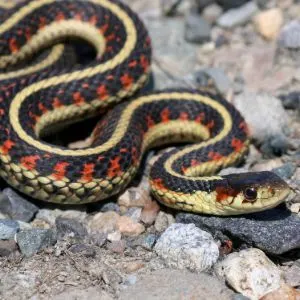
- Experience Level: Beginner
- Family: Colubridae
- Scientific Name: Thamnophis sirtalis
- Other Names: Garter Snake
- Adult Size: 23 to 30 inches; some can grow to 5 feet
- Lifespan: 4 to 5 years in the wild; up to 10 years in captivity
Common Garter Snakes are completely harmless to humans.
These guys are usually relatively small and like to remain active during the day. These guys like to soak often, so they will require a bowl in their tank for them to soak in, especially when it comes time to shed.
Garter snakes are great snakes for beginners since they are docile and will not grow to be too large.
Common Garter Snakes can range from dark olive-green to brown or black with a distinctive yellow stripe running throughout the length of their body.
When threatened, they may let off a musk in order to ward off predators. They can be found in many places like marshes, woodlands, meadows, or hillsides.
These snakes feed on leeches, slugs, worms, small fish, amphibians, and even other snakes. They are also immune to toxic frogs that secrete toxins from their skin in order to drive away prey.
32. Lined Snake

- Experience Level: Intermediate
- Family: Colubridae
- Scientific Name: Tropidoclonion
- Adult Size: 8 to 12 inches
- Lifespan: 3 to 10 years
We do not know much about Lined Snakes except that they are closely related to Garter Snakes, which help give us a little more information about these cute little critters.
These nocturnal snakes can often be found in urbanized areas, often discovered in parks, grassy areas, vacant lots, and under debris. They might also inhabit grasslands, abandoned prairies, woodland passages, oak forests, and suburban or residential areas.
They like to hide or find places to take shelter and will emit a musk if they are discovered or captured. They will rarely try to attack or bite someone.
They will often hide under leaf litter, rocks, or might burrow in the soil.
These tiny snakes basically look like mini Garter Snakes with brown or gray-brown bodies and dark stripes that can range from olive-gray to different ranges of grays.
Their undersides are cream-colored with two rows of gray blotches or spots. You may also find half-moons along their midline.
33. Rough Earthsnake

- Experience Level: Intermediate
- Family: Colubridae
- Scientific Name: Haldea striatula
- Other Names: Brown Ground Snake, Ground Snake
- Adult Size: 7 to 10 inches
- Lifespan: 7 years in the wild; significantly less in captivity
These tiny snakes might be super tempting to take into your care if you find one outside, but they really do not take well to captivity and will typically die very quickly. It is best to let them stay in their wild natural habitat.
Rough Earth Snakes are small, worm-like, brown-grey snakes with a tan or cream underside and tiny, beady eyes.
These tiny, worm-like snakes are endemic to many states from Virginia, Florida, the Gulf Coast, Texas, Missouri, and Kansas.
Rough Earth Snakes like to live in forested habitats or any areas that have rocks, leaf litter, compost piles, logs, and any other ground coverage for them to hide under. They can be found in a variety of different areas including urban habitats.
They feed almost exclusively on earthworms, but will also eat other invertebrates such as snails, slugs, larvae, and insect eggs.
34. Smooth Earthsnake
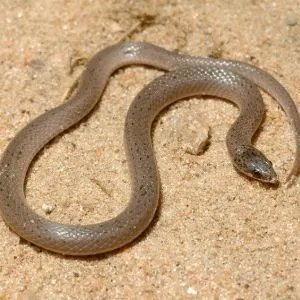
- Experience Level: Intermediate
- Family: Colubridae
- Scientific Name: Virginia valeriae
- Other Names: Western Smooth Earthsnake, Western Ground Snake, Western Earth Snake
- Adult Size: 7 to 19 inches
- Lifespan: Unknown; Shorter in captivity
Smooth Earthsnakes are on the smaller side and can range from light browns to greys or even a copper-like color. Their undersides are typically cream or off-white and they do not have any distinctive markings.
They are endemic to North America and have many different subspecies that might variate in coloration or patterns depending on their geographical region.
They like to live in habitats that are warm and humid. They prefer woodlands, moist woods, or woody hillsides where they can be found hiding under rocks and leaf litter.
They are nocturnal and like to hunt at night. These snakes feed on soft-bodied insects such as earthworms and slugs.
Venomous Snake Species in Kansas
Here is a list of the most venomous snakes that roam the state:
35. Broad-banded Copperhead

- Experience Level: Expert
- Family: Viperidae
- Scientific Name: Agkistrodon contortrix laticinctus
- Adult Size: 20 to 36 inches
- Lifespan: 40 years
These snakes are vertical-eyed with a heat-sensitive pit on each side of their heads right between their eye and nostrils. They are tan with large, coffee-brown blotches banding their body down to the tail.
They are endemic to the southern United States in Oklahoma, Kansas, and Texas near ponds or streams where they feed on mice, smaller snakes, frogs, and insects.
36. Eastern Copperhead

- Experience Level: Expert
- Family: Viperidae
- Scientific Name: Agkistrodon contortrix
- Other Names: Copperhead Snake
- Adult Size: average 2 to 3 feet; up to 4 feet
- Lifespan: 18 years
Copperheads aren’t aggressive towards humans unless provoked, which is why bites from them are somewhat rare, even in areas that they have been spotted.
These large snakes are tan in color with copper or rusty-looking, chestnut, blotches all throughout their bodies which look like spilled coffee spots. These pit vipers have a distinctively triangular-shaped head.
They can be found in a variety of environments anywhere from semiaquatic to terrestrial. This includes wetlands, hillside forests, rocky areas, and abandoned construction sites in the suburbs where they can find rotting wood or piles of sawdust.
These snakes are carnivorous, eating mostly small rodents like mice. They also consume other smaller snakes, lizards, insects, amphibians, and birds.
They do their hunting by ambushing their prey, injecting them with venom, then swallowing it whole.
37. Cottonmouth
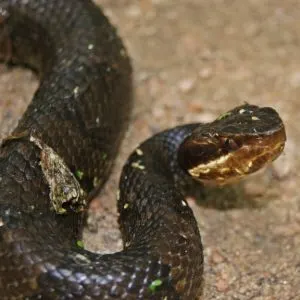
- Experience Level: Expert
- Family: Viperidae
- Scientific Name: Agkistrodon piscivorus
- Other Names: Water Moccasin
- Adult Size: 4 feet
- Lifespan: 10 years
Also known as Water Moccasins, Cottonmouths are generally dark brown or duller black with lighter side banding on some individuals.
These can be found in the Coastal Plain but can also be found throughout Piedmont of Atlanta, Georgia.
They prefer moist habitats like marshes, swamps, roadside ditches, streams, lakes, and retention ponds.
They feed on small mammals, birds, lizards, amphibians, fish, crayfish, insects, turtles, and even other snakes.
38. Timber Rattlesnake
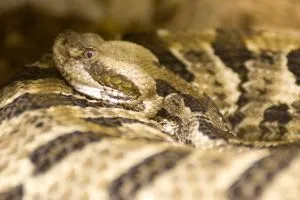
- Experience Level: Expert
- Family: Viperidae
- Scientific Name: Crotalus horridus
- Other Names: Canebrake Rattlesnake, Banded Rattlesnake
- Adult Size: 6 feet
- Lifespan: Anywhere from 10 to 30 years in the wild; 30+ years in captivity
Rattlesnake bites are very serious and should be treated as a medical emergency. However, they are also somewhat timid creatures, meaning they are not often spotted.
These vipers are usually gray or yellow-brown in color with dark brown blotches all or bands throughout their body and a brown, yellow, or copper stripe running down the length of their back.
They can generally be found in bluffs, croplands, rugged deciduous forest terrains, rocky ledges, and dense woodlands with closed canopies. They like to move around during different seasons and females will move to rocky terrains when they are pregnant for higher temperatures.
Timber Rattlesnakes feed mainly on smaller mammals but will also eat the occasional bird if they feel like it.
39. Prairie Rattlesnake

- Experience Level: Expert
- Family: Viperidae
- Scientific Name: Crotalus viridis
- Other Names: Western Rattlesnake, Great Plains Rattlesnake
- Adult Size: 5 feet
- Lifespan: 16 to 20 years in the wild; 24 years max in captivity
If you suffer a bite from this viper and don’t get it treated, it can be very dangerous, and even fatal.
This venomous pit viper is a tan, hefty rattlesnake with dark brown blotches or bands along their backsides, splitting into dark olive or brown rings at their tail.
They can be spotted in sagebrush, grasslands, and high rocky ledges. Prairie Rattlesnakes mostly consume various kinds of rodents like prairie dogs and rabbits.
40. Western Massasauga

- Experience Level: Expert
- Family: Viperidae
- Scientific Name: Sistrurus catenatus tergeminus
- Other Names: Western Massasauga, Desert Massasauga Rattlesnake
- Adult Size: about 2 feet
- Lifespan: 14 years
The Massasauga is protected by The U.S. Fish and Wildlife Service under the Endangered Species Act. This means that they cannot be taken from the wild and are not to be messed with.
A bite from one of these vipers will not be one you will forget and could also kill you since they are one of the most venomous snakes in the United States. Although, they are quite shy creatures which is why bites don’t happen too often and are considered a rare occurrence.
Massasaugas are tan or gray in color with bright brown blotches along their back and smaller blotchy patterns along their sides.
In the wilderness, they choose to live in open, rocky areas since these environments will allow them to bask freely with multiple options. They may also be found in deserts, forests, prairies, and marshes.
They like areas where they can take cover from bird predators and where prey is abundant. They will eat insects, lizards, smaller snakes, and amphibians but they mainly feed on smaller mammals.
When hunting, these vipers are the stalking type, sitting and waiting for their prey. They have special pits near each of their eyes that are heat-sensitive and will alert them when prey is near.
They will then inject them with a little bit of their toxic venom before swallowing them whole.
Conclusion
Kansas definitely has many interesting species of snakes to check out.
Whether you are an enthusiast that wants to learn more about keeping or are just a novice reptile lover, we hope that this article brought you some value.
Leave us a comment down below about what you think about the snakes in the state of Kansas.
Snakes in other states
References
https://gpnc.org/wp-content/uploads/sites/32/2018/02/KS-Snakes.pdf
https://webapps.fhsu.edu/ksherp/bibFiles/21647.pdf
